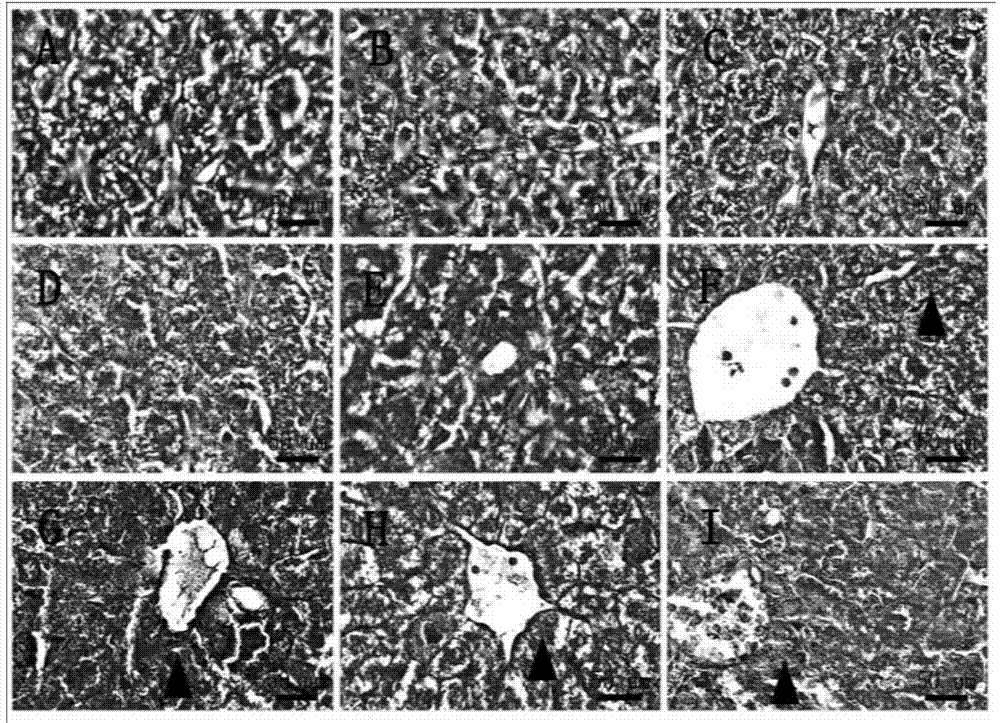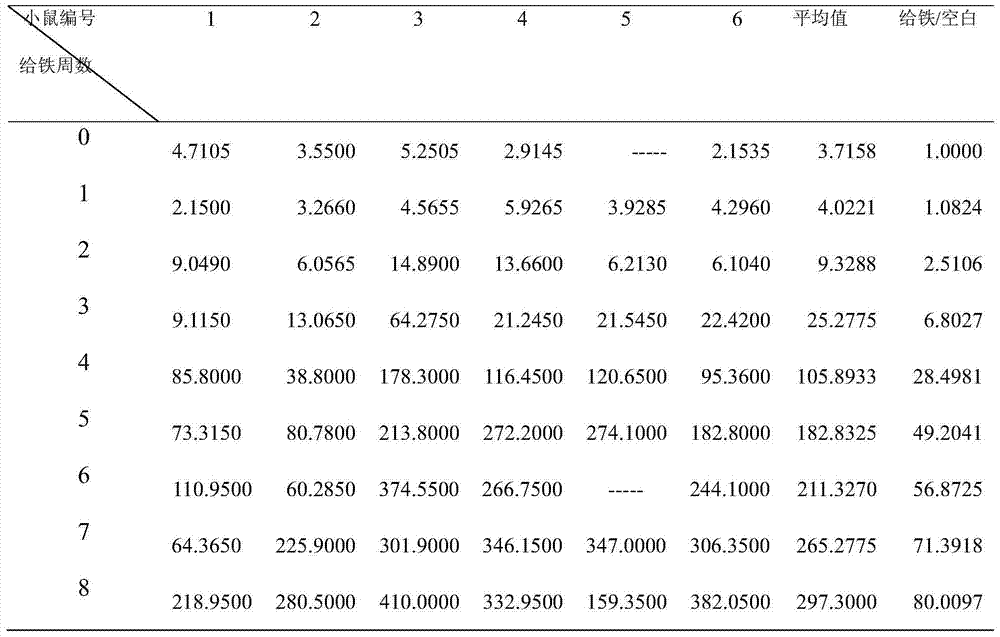Method for establishing iron-overload mouse model corresponding to thalassemia Pesaro risk classification
A risk classification and mouse model technology, applied in the biological field, can solve problems such as patient death, adverse reactions, transplant rejection or recurrence, and achieve the effects of ensuring dosage, avoiding gastrointestinal irritating damage, and avoiding poisoning death
- Summary
- Abstract
- Description
- Claims
- Application Information
AI Technical Summary
Problems solved by technology
Method used
Image
Examples
Embodiment 1
[0022] The establishment of a class I iron overload mouse model corresponding to the Pesaro risk classification of thalassemia includes the following steps:
[0023] Take healthy C57BL / 6 mice, male, 8 weeks old, weighing 19-23 grams. They were reared at 23±2°C and relative humidity of 55±5%, and the light / darkness was set as a 12h / 12h day and night cycle. They were given regular feed every day, free to eat and drink, and changed the litter 2-3 times a week. Iron dextran (Fe content 100 mg / ml) was injected intraperitoneally, 1 g iron element / kg body weight, once a week for a total of 1 week. The experiment was repeated three times.
[0024] The liver enlargement degree of mice was quantitatively analyzed by liver index (ratio of liver weight to body weight) and liver weight increase ratio [(liver index of mice in each group-liver index of control group) / liver index of control group*100]. The results in Table 1 show that the liver weight of mice increased by 18.7% after admin...
Embodiment 2
[0029] The establishment of a level II iron overload mouse model corresponding to the Pesaro risk classification of thalassemia includes the following steps:
[0030] Take healthy C57BL / 6 mice, male, 8 weeks old, weighing 19-23 grams. They were reared at 23±2°C and relative humidity of 55±5%, and the light / darkness was set as a 12h / 12h day and night cycle. They were given regular feed every day, free to eat and drink, and changed the litter 2-3 times a week. Intraperitoneal injection of iron dextran (Fe content 100mg / ml), 1g iron element / kg body weight, 1 time / week, administration for 2-4 weeks. The experiment was repeated three times
[0031] The results in Table 1 show that the mouse liver weight increased by 50.7-81.9% after 2-4 weeks of administration of iron dextran, and the weight increase was greater than 50%. It can be judged that the mouse has reached the corresponding standard of human liver enlargement exceeding 2cm in the Pesaro risk classification at this time ...
Embodiment 3
[0036] The establishment of a grade III iron overload mouse model corresponding to the Pesaro risk classification of thalassemia includes the following steps:
[0037] Take healthy C57BL / 6 mice, male, 8 weeks old, weighing 19-23 grams. They were reared at 23±2°C and relative humidity of 55±5%, and the light / darkness was set as a 12h / 12h day and night cycle. They were given regular feed every day, free to eat and drink, and changed the litter 2-3 times a week. Intraperitoneal injection of iron dextran (Fe content 100mg / ml), 1g iron element / kg body weight, 1 time / week, administration for 5-8 weeks. The experiment was repeated three times
[0038] The results in Table 1 show that the mouse liver weight increased by 92.3-135.7% after 5-8 weeks of administration of iron dextran, and the weight increase was greater than 50%. It can be judged that the mouse has reached the corresponding human liver enlargement of more than 2cm in the Pesaro risk classification at this time. standard...
PUM
 Login to View More
Login to View More Abstract
Description
Claims
Application Information
 Login to View More
Login to View More - R&D
- Intellectual Property
- Life Sciences
- Materials
- Tech Scout
- Unparalleled Data Quality
- Higher Quality Content
- 60% Fewer Hallucinations
Browse by: Latest US Patents, China's latest patents, Technical Efficacy Thesaurus, Application Domain, Technology Topic, Popular Technical Reports.
© 2025 PatSnap. All rights reserved.Legal|Privacy policy|Modern Slavery Act Transparency Statement|Sitemap|About US| Contact US: help@patsnap.com



